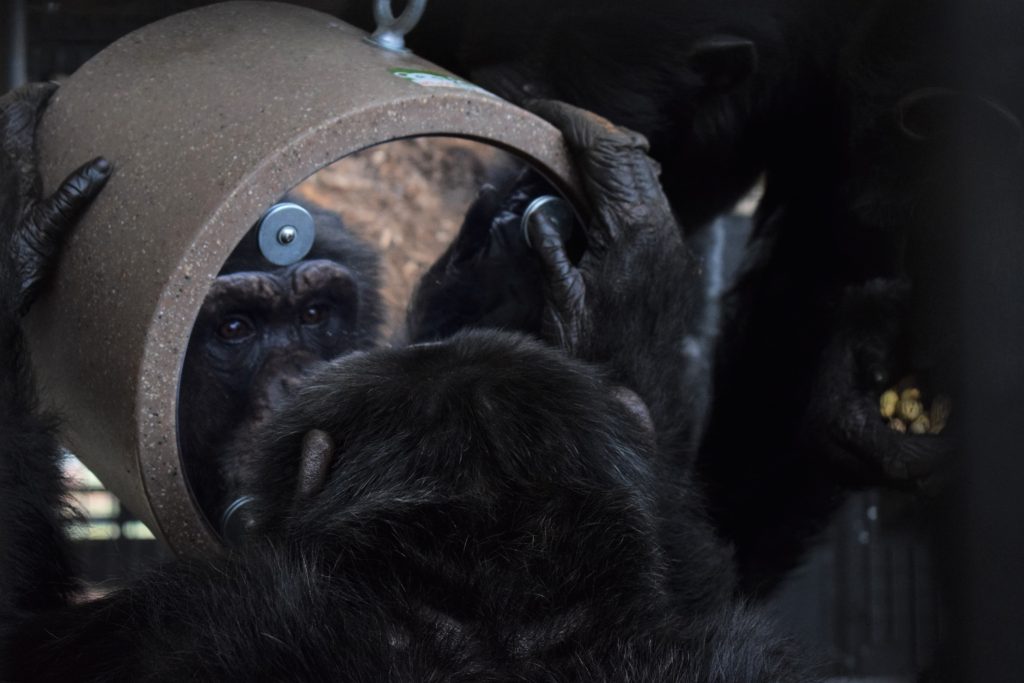
From Studying Chimps to Seeing Chimps

By Anna Lietman
Studying Chimps
Staff member India Sloan grew up within two hours of Project Chimps. It was only coincidentally that once she left Georgia for college, she developed a keen interest in chimps, and began to focus her studies on primates. She eventually made her way back to her home state, and to Project Chimps.
Meeting Chimps
Studying chimps in her textbooks, India ultimately discovered, does not compare to meeting them in real life. She remembers her first day at Project Chimps clearly, because on this day she came face to face with a chimp for the first time.

She first met Marlon, who came up to the window during her tour, asking for kisses through the glass. This moment resonated differently than her schooling. It brought chimps from a surreal concept to a reality.
Studying Project Chimps’ Chimps
Once at Project Chimps, India embarked right away on one of the most important tasks for new staff: learning to tell the chimps apart. She’s good with names, but nevertheless struggled at the beginning. She couldn’t tell Sarah from Amy, or Oscar from Kivuli.
She looks back now and laughs. Now that she’s spent five months among the chimps, they look drastically different in her eyes. She can tell Oscar from Kivuli at a distance, no problem.
Her trick? Homing in on their ears.
When memorizing individuals, she took notes. She wrote each chimp’s name and any distinguishing features. But really, their ears gave them away. Binah has one really pointy elfin ear. Oscar has what she calls “folded-over ears.” Kareem’s ears are “kind of flat on top.”
Ear sketches dot her early notebook pages:




Learning From Chimps
Though she finished studying chimps in school, India still manages to learn quite a lot.
All of us have likely heard of chimpanzees’ impressive tool use capabilities, and been given the example of chimps poking sticks into termite mounds. But it wasn’t until she came to Project Chimps that India learned of other instances of tool use.
Mesmerized, India watched as Panielle tore a blanket into differently-sized strips in order to fashion a purse. She then understood: Painelle affixes her blanket pieces to a stick so that she can take them with her, hands-free. She’ll walk using all four limbs and rest the stick in the crook of her armpit, blanket trailing over her shoulder.

“That’s the kind of tool use aspect that you can see in real life. Because most of the time, the tool use you hear about in school is [monotone voice] ‘they use sticks to go into termite mounds to get the bugs out.’ And they do do that here… But I think watching them do other things, like Panielle putting her blanket on a stick so that she can use both of her hands when she’s walking—that’s really interesting to see.”
India Sloan
Teaching About Chimps
India tells me excitedly about her plans to teach others about chimps. I can hear the passion in her voice when she talks about counteracting a recent TikTok trend featuring videos of chimps performing human-like tasks—driving cars, making coffee.
“That’s really big on TikTok—people posting their chimps dressed up like humans. And that’s something I would really like to change the narrative around. I want people to understand that that’s really problematic.”
India Sloan

Chimps are not pets, she emphasizes, nor are they toys for people to dress-up. With her up-and-coming Project Chimps TikTok campaign, India aims to show chimps at sanctuary living as they’re meant to live, free of exploitation.
Follow Project Chimps on TikTok to track India’s campaign.

